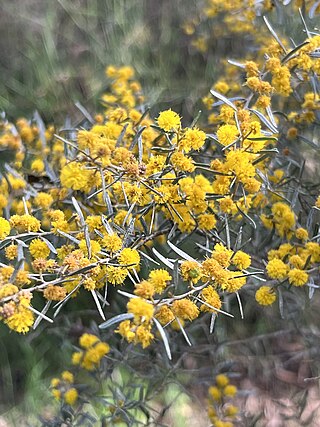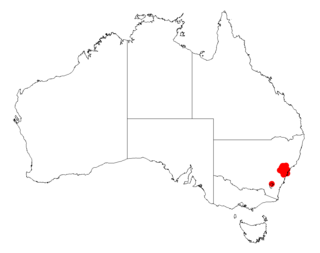
Acacia howittii, commonly known as sticky wattle or Howitt's wattle, is a tree species that is endemic to Victoria, Australia.

Acacia hispidula, known colloquially as little harsh acacia, rough-leaved acacia or rough hairy wattle, is a species of Acacia native to eastern Australia.

Acacia arcuatilis is a shrub belonging to the genus Acacia and the subgenus Juliflorae that is endemic to south western parts of Australia.

Acacia repanda is a shrub belonging to the genus Acacia and the subgenus Juliflorae that is endemic to a small area in western Australia.

Acacia bracteolata is a shrub belonging to the genus Acacia and the subgenus Phyllodineae endemic to Western Australia.

Acacia dentifera, commonly known as tooth-bearing acacia, is a shrub belonging to the genus Acacia and the subgenus Phyllodineae that is endemic to south western Australia.

Acacia georgensis, commonly known as Bega wattle or Dr George Mountain wattle, is a species of Acacia native to southeastern Australia. It was one of eleven species selected for the Save a Species Walk campaign in April 2016 when scientists walked 300 km to raise money for collection of seeds to be prepared and stored at the Australian PlantBank at the Australian Botanic Garden Mount Annan.

Acacia eremaea is a shrub or tree of the genus Acacia and the subgenus Plurinerves that is endemic to an area in western Australia.

Acacia trulliformis is a shrub of the genus Acacia and the subgenus Plurinerves that is endemic to an area of south western Australia.

Acacia vittata, commonly known as Lake Logue wattle, is a shrub of the genus Acacia and the subgenus Plurinerves that is endemic to a small area in western Australia.

Acacia barringtonensis, commonly known as Barrington wattle, is a shrub belonging to the genus Acacia and the subgenus Phyllodineae endemic to New South Wales.

Acacia costiniana, commonly known as Costin's wattle, is a shrub belonging to the genus Acacia and the subgenus Phyllodineae that is endemic to eastern Australia.

Acacia wilhelmiana, commonly known as dwarf nealie, Wilhelmi’s wattle and mist wattle, is a shrub belonging to the genus Acacia and the subgenus Plurinerves native to the mallee region of central and eastern Australia.

Acacia ruppii, commonly known as Rupp's wattle, is a shrub belonging to the genus Acacia and the subgenus Phyllodineae native to eastern Australia. It is listed as endangered in the Environment Protection and Biodiversity Conservation Act 1999.

Acacia saliciformis is a shrub or tree belonging to the genus Acacia and the subgenus Phyllodineae native to eastern Australia.

Acacia kydrensis, commonly known as Kydra wattle, is a shrub of the genus Acacia and the subgenus Phyllodineae that is endemic to south eastern Australia.

Acacia blakei, commonly known as Blake's wattle or Wollomombi wattle, is a shrub belonging to the genus Acacia and the subgenus Juliflorae that is native to north eastern Australia.

Acacia gracilenta is a shrub belonging to the genus Acacia and the subgenus Juliflorae that is native to north Australia.

Acacia williamsiana is a tree or shrub belonging to the genus Acacia and the subgenus Juliflorae that is native to eastern Australia.

Acacia pycnostachya, also known as Bolivia wattle, is a shrub or tree belonging to the genus Acacia and the subgenus Juliflorae that is native to eastern Australia.






















